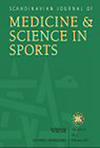在高温下,湿度升高会损害蒸发热量损失和自定节奏的运动表现
IF 3.5
2区 医学
Q1 SPORT SCIENCES
引用次数: 0
摘要
本研究调查了绝对湿度对热环境下自我节奏运动的散热和随后的热反应、心血管反应和运动表现的影响。12名训练有素的男性自行车手在33°C的四种不同湿度条件下(低:1.6千帕,中:2.5千帕,高:3.5千帕,高:4.5千帕)进行了700千焦的计时赛。饱和皮肤表面和空气中决定汗液蒸发的部分水汽压梯度随着湿度的增加而显著降低(低:3.53±0.30 kPa,中:2.74±0.24 kPa,高:1.99±0.20 kPa,极高:1.19±0.16 kPa;p & lt;0.001)。环境的最大蒸发容量(Emax)也随着湿度的增大而减小(低:309±26 W m−2,中:240±21 W m−2,高:175±18 W m−2,极高:104±14 W m−2;p & lt;出汗效率(Seff)(低:0.50±0.13,中等:0.39±0.10,高:0.28±0.09,非常高:0.16±0.04;P≤0.003)。低湿度(260±33 W)与中湿度(257±27 W)输出功率相近;p = 0.999),但在非常高(222±37 W)条件下低于其他所有条件(p <;0.001),高湿度(246±31 W)低于低湿度和中湿度(p <;0.001)。极高温度(39.49°C±0.56°C)高于低温度(38.97°C±0.44°C);p & lt;0.001),中度(39.04°C±0.39°C;p = 0.002)和高湿度(39.12°C±0.47°C;P = 0.010)。平均皮肤温度随湿度升高而升高(p <;0.001),两组间平均心率无显著差异(p≥0.056)。这些数据表明,湿度升高导致蒸发势和效率的降低,加剧了高温下自行骑行时的热负荷和心血管负荷,导致显著的性能障碍。本文章由计算机程序翻译,如有差异,请以英文原文为准。
Elevated Humidity Impairs Evaporative Heat Loss and Self‐Paced Exercise Performance in the Heat
This study investigated the effects of absolute humidity on heat dissipation and subsequent thermal, cardiovascular, and performance responses during self‐paced exercise in the heat. Twelve trained male cyclists performed a 700‐kJ time trial in four different humidity conditions (Low: 1.6 kPa, Moderate: 2.5 kPa, High: 3.5 kPa, and Very high: 4.5 kPa) in 33°C. The gradient in partial water vapor pressure at the saturated skin surface and in air, which determines sweat evaporation, decreased significantly with increasing humidity (Low: 3.53 ± 0.30 kPa, Moderate: 2.74 ± 0.24 kPa, High: 1.99 ± 0.20 kPa, Very high: 1.19 ± 0.16 kPa; p < 0.001). The maximum evaporative capacity of the environment (E max ) also decreased with greater humidity (Low: 309 ± 26 W m−2 , Moderate: 240 ± 21 W m−2 , High: 175 ± 18 W m−2 , Very high: 104 ± 14 W m−2 ; p < 0.001), as did sweating efficiency (S eff ) (Low: 0.50 ± 0.13, Moderate: 0.39 ± 0.10, High: 0.28 ± 0.09, Very high: 0.16 ± 0.04; p ≤ 0.003). Power output was similar between Low (260 ± 33 W) and Moderate humidity (257 ± 27 W; p = 0.999), but lower in Very high (222 ± 37 W) than in all other conditions (p < 0.001) and lower in High (246 ± 31 W) than in the Low and Moderate humidity (p < 0.001). Peak core temperature was higher in Very high (39.49°C ± 0.56°C) than in Low (38.97°C ± 0.44°C; p < 0.001), Moderate (39.04°C ± 0.39°C; p = 0.002) and High humidity (39.12°C ± 0.47°C; p = 0.010). Mean skin temperature was higher with elevated humidity (p < 0.001) and mean heart rate was not significantly different between conditions (p ≥ 0.056). These data indicate that reductions in evaporative potential and efficiency with elevated humidity exacerbate thermal and cardiovascular strain during self‐paced cycling in the heat, resulting in marked performance impairments.
求助全文
通过发布文献求助,成功后即可免费获取论文全文。
去求助
来源期刊
CiteScore
7.90
自引率
4.90%
发文量
162
审稿时长
3 months
期刊介绍:
The Scandinavian Journal of Medicine & Science in Sports is a multidisciplinary journal published 12 times per year under the auspices of the Scandinavian Foundation of Medicine and Science in Sports.
It aims to publish high quality and impactful articles in the fields of orthopaedics, rehabilitation and sports medicine, exercise physiology and biochemistry, biomechanics and motor control, health and disease relating to sport, exercise and physical activity, as well as on the social and behavioural aspects of sport and exercise.

 求助内容:
求助内容: 应助结果提醒方式:
应助结果提醒方式:


